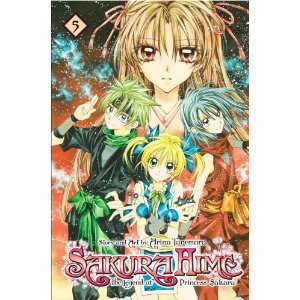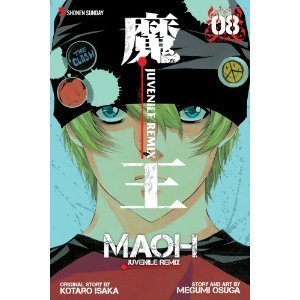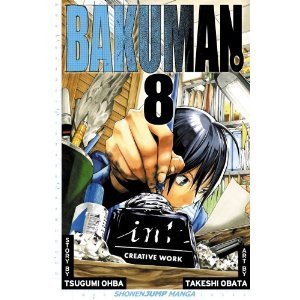S.Q. Eries's Blog, page 71
January 19, 2012
Manga Review: My Girlfriend's A Geek Vol. #05
 Within anime/manga fandom, there is a subset devoted to yaoi or boys' love type stories. Fans of this sort tend to be very passionate about their favorite genre, and My Girlfriend's a Geek (based off a popular Japanese blog) relates the adventures of a non-otaku dating one such fan.
Within anime/manga fandom, there is a subset devoted to yaoi or boys' love type stories. Fans of this sort tend to be very passionate about their favorite genre, and My Girlfriend's a Geek (based off a popular Japanese blog) relates the adventures of a non-otaku dating one such fan.
Yen Press has recently released the final volume of this series, and you can read on for the review. (You can also click here if you're interested in my reviews of earlier volumes).
Back Cover Blurb
Dating a "rotten" girl geek is no easy feat, as Taiga knows well. But after overcoming some of the strangest hurdles and learning to accept Yuiko's fangirl tendencies, he's over the moon now that their comical but loving relationship is stronger than ever! But when the fanfic he's been diligently writing for Yuiko brings Taiga some sudden and unwelcome Internet notoriety, will he be able to withstand the onslaught of a zillion Yuikos, or will he run away screaming from his happy ending?!
The Review
Shinba-sensei strikes me as having lost steam with the Taiga/Yuiko relationship. Of four chapters, only one really focuses on the couple so it doesn't surprise me that this is the final volume. Still, this installment was much more entertaining than previous volumes I've read, mainly because of new characters Koharu and Youhei.
Shinba-sensei puts a new twist on the normal-person-sucked-into-yaoi-fandom theme with a college-age doujinshi writer and his roommate. Unlike the Taiga/Yuiko relationship where Yuiko capitalizes on her boyfriend's affection to drag him into her "rotten" world, Youhei has no such leverage with Koharu, meaning that Youhei has to resort to other kinds of trickery to force him in. Koharu, though, is hardly the pushover type so the roommates' interactions are much more interesting than Yuiko and Taiga's weird romance.
As for the series conclusion, My Girlfriend's a Geek generally felt like a collection of one-shots, and its lack of a strong driving story arc meant its final chapter seemed like simply another chapter. In fact, I wouldn't have guessed the series had concluded if not for the "FINAL" on the cover.
By the way, this final volume's extras include an afterword essay (where Pentabu gets the best of Y-ko for once), a mini comic about Akari, and bonus illustrations.
In Summary
The series concludes! The Taiga/Yuiko relationship has grown somewhat stale, but Shinba-sensei makes up for it with the comic interactions of a male closet doujinshi author and his straight-laced roommate.
First published at the Fandom Post.








January 16, 2012
Ancient Olympic Fun Fact 3
2012 is significant in that it is a presidential election year, a leap year, and a summer Olympic year! The modern Olympics, of course, were inspired by the ancient Greek Olympics, a subject I've been researching for my work in progress. So in these months leading to the 2012 London Games, I'll be posting weekly tidbits about the original athletic festival that started it all.
Here's this week's fun fact:
Married women were barred from attending the Games.
At other times of the year, women could enter Olympia, where the Games took place, but during the competition, they had to stay out. The one exception to the rule was the priestess of Demeter Chamyne, whose presence was actually required at the Games. As for the rest, Pausanias writes:
As you go from Scillus along the road to Olympia, before you cross the Alpheius,there is a mountain with high, precipitous cliffs. It is called Mount Typaeum. It is a law of Elis to cast down it any women who are caught present at the Olympic Games, or even on the other side of the Alpheius, on the days prohibited to women. (Book 5, Chapter 6, Section 7 of the Description of Greece)
However, the confusing thing is that in chapter 20 of the same book, Pausanias writes, "Maidens are not debarred from looking on at the Games."
So it appears there were some females at the Games – at least in Pausanias' time. But that doesn't necessarily mean it was always the case. The Games were centuries old at the time of Pausanias, and the dominating Romans may have tweaked the rules when they overran Greece. It's also not clear whether the term "maidens" meant entry was based off age or marital status.
At any rate, if you were a woman and married, you'd stay well clear of Olympia during the Games.
Tune in next week for more about the ancient Olympics!








January 9, 2012
Ancient Olympic Fun Fact 2
2012 is significant in that it is a presidential election year, a leap year, and a summer Olympic year! The modern Olympics, of course, were inspired by the ancient Greek Olympics, a subject I've been researching for my work in progress. So in these months leading up to the 2012 London Games, I'll be posting weekly tidbits about the original athletic festival that started it all.
Here's this week's fun fact:
Only free-born Greeks could compete in the Games
While athletes from all over the world compete in the modern Olympics, only those of Greek descent could enter the original competition in Olympia. It should be noted though that Greece at the time was a far from a unified entity so in a sense it was an interstate competition. Not to mention, the concept of an athletic festival was utterly foreign to other cultures.
However, things did change when Rome took over Greece. The Romans liked a lot about Greek culture, including their sports, and they compelled the Games to open up to Roman officials. The Emperor Nero very famously entered one Olympiad where he took the crown for the chariot competition despite falling off of his ten-horse chariot (all the other competitors had four-horse chariots). Eventually, all Roman citizens, whether Egyptian or Spaniard, Syrian or Armenian, could take part, turning the Games from a panhellenic festival to a more universal one.
Tune in next week for more about the ancient Olympics!








January 3, 2012
Ancient Olympic Fun Fact 1
Happy new year! I'm a bit tardy in my new year's greetings, but 2011 closed with a time-consuming termite problem so I hope you'll accept that as an excuse. Anyway, 2012 is significant in that it is a presidential election year, a leap year, and a summer Olympic year! The modern Olympics, of course, were inspired by the ancient Greek Olympics, a subject I've been researching for my work in progress. So in these months leading up to the 2012 London Games, I'll be posting weekly tidbits about the original athletic festival that started it all.
So to start off, here's this week's fun fact:
The very first Olympiad consisted of one event.

The track at Olympia
Yup, one. In contrast to the seemingly endless list of sports in the modern-day Olympics, the first Games consisted of the stade-race, a 600-foot sprint. About a half century later, they added a second event (the two-stadia race), and as time went on (and the Games grew in popularity), other events were added and sometimes discontinued. But the men's stade-race was the only event featured in every single Olympiad. It had such significance that Olympiads were named after the winner of the event. So, for example, if Leonidas won the stade-race a certain year, that particular Olympiad would be referred to as the Olympiad of Leonidas.
How's that for motivation to win the race? 
Tune in next week for more about the ancient Olympics!








December 24, 2011
Merry Christmas from us and … Milton
 Our housemate CL gave me and my husband our Christmas present before leaving for the East Coast, and it was so unique I had to share it. This is Milton, a fully functional Muppet, handmade by CL.
Our housemate CL gave me and my husband our Christmas present before leaving for the East Coast, and it was so unique I had to share it. This is Milton, a fully functional Muppet, handmade by CL.
CL has been, as my husband puts it, undergoing a personal renaissance. Earlier this year, he chanced across the Puppet School in the San Fernando Valley and instantly got sucked into Muppetry. The funny thing is, I don't think he's ever touched a needle before this, and now he meets with fellow Muppet enthusiasts for sewing sessions.
He's made so many Muppets I suspect they'll eventually take over his room. And he's spreading the wealth. In addition to Milton, he's got four Muppets packed in his luggage, one for each member of his family. (They're all adults and mostly medical doctors). My husband jokes that it'll make for an interesting dynamic at their dinner table this year.
And may your Christmas also be filled with joy, wonder, and fun (though not necessarily with Muppets). Merry Christmas and happy new year all!








December 20, 2011
Manga Review: Sakura Hime Vol. 5
Arina Tanemura is a popular shojo mangaka, and one of her works currently being translated into English is Sakura Hime, a magical shojo story that puts a twist on a famous Japanese legend. Volume 5 has recently been released, and you can read on for the review. (Also, for those who are interested, you can click here for my reviews of earlier volumes).
 The story centers on Sakura, the granddaughter of the Moon princess Kaguya. As her descendent, Sakura wields the power to defeat Youko, monsters from the Moon, but Sakura's Moon heritage also means she's predisposed to becoming a Youko herself…
The story centers on Sakura, the granddaughter of the Moon princess Kaguya. As her descendent, Sakura wields the power to defeat Youko, monsters from the Moon, but Sakura's Moon heritage also means she's predisposed to becoming a Youko herself…
Back Cover Blurb
Aoba and the others storm Enju's hidden palace to rescue Sakura. Byakuya must defeat Maimai for the key to the tower where Sakura is being held. Maimai is a ruthless killer, but Byakuya is about to unleash her secret powers…
The RevieW
At the end of the previous volume, Byakuya looked like she was in deep trouble, but given her abilities and wisdom, you'd suspect she'd be able to get out of it on her own. And she does – in a manner that's surprising in more ways than one. Apparently, Sakura and Asagiri aren't the only ones capable of transformation, and Byakuya's triumph over Maimai unveils a previously unseen aspect that gives the hitherto mundane sage an air of mystery.
The story then moves on to the next fight between Kohaku and the deserter ninja Shuri. Those who are fans of the ninja characters will enjoy flashbacks of Kohaku, Shuri, and Hayate as children, but the focus is less on Enju's minion Shuri and more on Kohaku.
With this arc, it feels like Tanemura-sensei's trying to inject a bit of Naruto into the series with the ninja village and the child ninja who wants so badly to become the next leader. Kohaku, however, is not the underdog that Naruto is. As the current leader's daughter, she's hardly an outcast, and she's beloved by her peers. So she doesn't evoke the level of sympathy Naruto does and comes across instead as a klutzy crybaby, especially when she vows never to cry again and is bawling seven pages later. Given the mistakes Kohaku's made thus far in the series, seeing her holding her own against Shuri is a bit of a stretch. It's also rather strange that the Prince and the others don't just leave Kohaku to dispatch Shuri and go rescue Sakura. Instead, everyone takes a seat to watch the fight, as if it's a match in the ninja chunin exams, despite the fact that they're very much in enemy territory.
By the way, Volume 5 includes several extras including bonus funnies, bonus illustrations, and the 50-page one-shot White Rose Academy: Vampire Rose.
In Summary
The Maimai/Byakuya battle ends with a surprising revelation. The story then moves on to ninjas Kohaku and Shuri. Through a series of flashbacks, Tanemura-sensei casts an air of tragedy over the fight between former friends, but from a battle standpoint, her depiction of the duel feels flawed.
First published at the Fandom Post.








December 16, 2011
Manga Review: Maoh: Juvenile Remix Vol. #08 Review
I don't usually review a whole lot of shonen manga, and I review even fewer violent shonen titles. Somehow, though, I wound up with the Maoh series, which has murder and mayhem in spades.(My reviews of earlier Maoh: Juvenile Remix volumes can be found here.) However, it's more of a supernatural thriller than a gratuitous show of blood splattering and has some interesting heroes (if you can stomach all the casualties along the way).
 The story takes place in Nekota City, which is not so much a dystopia as it is a community on the decline (think Gotham City from Batman). Inukai is the mysterious leader of a vigilante group called Grasshopper, which is at odds with the city's redevelopment plan. Inukai is hailed as a hero among the common folk of Nekota, but is he really all that he seems?
The story takes place in Nekota City, which is not so much a dystopia as it is a community on the decline (think Gotham City from Batman). Inukai is the mysterious leader of a vigilante group called Grasshopper, which is at odds with the city's redevelopment plan. Inukai is hailed as a hero among the common folk of Nekota, but is he really all that he seems?
Back Cover Blurb
Still trying to recover from the shock of his brother's death, Junya decides to follow in Ando's footsteps. First on the agenda is revenge on the ones who caused his brother's death. Can Junya succeed where Ando failed…?
The Review
Having chosen to dive the underworld, Junya can't seem to take two steps without running into assassins. He starts off by arranging a showdown with the Duce bartender, but their confrontation gets abruptly cut off when the Pusher, the greatest killer in the business, interferes. (The images for this scene are pretty intense. You can practically feel the rumble of the truck as it crashes through.) The Pusher's meddling is a wholly unexpected twist and sends Junya on a journey that takes him to other supernaturally gifted individuals; a sadistic shadowy group known as Fraulein (you'll be gripping your fingernails after meeting them); and ultimately, Inukai.
As angry and vengeful as Junya is, he's still very much grieving for his brother. Every now and then, something triggers a memory, and he winds up in tears. It's proof of his affection for his brother, and with a bond so close, it makes absolute sense that Junya's the critical link to Ando's dramatic reappearance when Junya confronts Inukai.
In the meantime, reform in Nekota City isn't proceeding the way its good citizens would hope. The convenient demises of Grasshopper's opponents is weighing on the new mayor, forcing him into the very tricky position of striking a deal with unsavory characters to try to gain an upper hand on the underworld. Whatever's going to happen next, it feels like all involved are going to sink further into darkness.
In Summary
Junya's out for revenge, and not even the threat of death or violence can stop him. It's one gripping encounter after another as Junya gets to the bottom of what happened to his brother. He's gone through a dramatic transformation in the last few chapters, but that's nothing compared to what happens when he discovers the truth from Inukai himself!
This title is rated Older Teen for lotsa blood and violence and an intense plot.
First published at the Fandom Post.








December 9, 2011
Manga Review: Dengeki Daisy Vol. 7
Bad boy/good girl love stories are popular in shojo manga, and for those who enjoy a dash of cyber intrigue in their romances, Kyousuke Motomi's Dengeki Daisy is worth checking out. Volume 7 has recently been released, and you can read on for the review. (Also, for those who are interested, you can click here for my reviews of earlier volumes).
 The story centers on orphan Teru Kurebayashi, who, after the death of her beloved older brother, finds solace in the messages she exchanges with Daisy, an enigmatic figure who can only be reached through the cell phone her brother left her. One day, she accidentally breaks a window at school, and as a result winds up becoming a servant for Kurosaki, the delinquent school custodian. Although brusque and rude, he somehow always shows up in her time of need, and Teru finds herself increasingly drawn to him.
The story centers on orphan Teru Kurebayashi, who, after the death of her beloved older brother, finds solace in the messages she exchanges with Daisy, an enigmatic figure who can only be reached through the cell phone her brother left her. One day, she accidentally breaks a window at school, and as a result winds up becoming a servant for Kurosaki, the delinquent school custodian. Although brusque and rude, he somehow always shows up in her time of need, and Teru finds herself increasingly drawn to him.
Back Cover Blurb
Kurosaki decides that he needs to tell Teru the truth, but little does he know that an unsettling fellow called Akira has other ideas. What is Akira scheming, and how will his actions irrevocably affect Teru's relationship with Kurosaki?
The RevieW
The way Teru bumps into the weird hoodie guy in the last volume it's pretty much a given he's going to return, and he does, in a big way. The shadowy Akira adds on to the cast of bad guys, and though he's in cahoots with Mori, he is a bit of a loose cannon. He seems less interested in the intrigue surrounding Daisy and more interested in messing with Teru's mind, which he's quite effective at, especially since he physically resembles her brother. It's still not quite clear what he and Mori are after, but we do get more hints about Daisy's less than upstanding past.
At any rate, Akira's mischief does the trick of pushing Teru and Kurosaki's relationship along. When Teru gets her first kiss stolen, her reaction is standard shojo stuff. Kurosaki's, however, is adorably hilarious, and what follows is an entire chapter of Kurosaki agonizing over the convoluted situation between him and Teru. Despite all the guilt and angst Kurosaki struggles through, Motomi-sensei does a good job of injecting just enough humor so that the plot doesn't get completely bogged down.
Kurosaki's ultimate decision to confess to Teru will probably draw a collective "Finally!" from Motomi-sensei's readers. Of course, such confessions never go as planned, and it's little surprise when Akira and Mori show up to ruin things. It's almost too easy how Kurosaki takes down Mori, but with Teru in Akira's clutches at the end of the volume, the story seems headed toward another big rescue/confrontation in Volume 8.
In Summary
Teru and Kurosaki have been doing the dance of Kurosaki holding back and Teru pretending she doesn't know Kurosaki's secret for a while now, but the time has come for the truth to be revealed. As that moment approaches, there's more than enough emotional angst to satisfy the shojo reader as well as a helping of intrigue as Mori and her shadowy accomplice Akira seek to turn Kurosaki's confession into an opportunity for themselves.
First published at the Fandom Post.








December 3, 2011
Manga Review: Bakuman Vol. 8
Bakuman is the latest collaboration of Ohba and Obata, the creators of the wildly popular Death Note series. Unlike Death Note, Bakuman is more or less grounded in reality, but it is no less entertaining as it follows the ups and downs of a mangaka duo as they strive to make it big in the publishing world!
This series is a personal favorite of mine, and Viz Media has just released Volume 8. (My reviews of earlier Bakuman volumes can be found here.)

Back Cover Blurb
Drama swirls around the manga creators as they try to move forward after being canceled from Shonen Jump. Moritaka and Akito work hard on a new comedy story pitch while Aoki and Nakai struggle with some personal issues. But when Kaya uncovers Akito's meetings with Aoki and Iwase, things might never be the same.
The Review
Certain volumes of this series have really come across as battle manga – and this is not one of them. While Team Ashirogi is still struggling hard for a breakthrough that will allow them to return to the pages of Jump, the overall feel of Volume 8 is romantic dramedy. And it's not just the boys and their girlfriends. To varying degrees, Iwase, Aoki, Nakai, and the assistant Kato all wind up embroiled in affairs of the heart, and the situations that result have a very high school shojo feel to it. (Not that I'm complaining; I actually enjoy this sort of thing.)
In the midst of all this who's-attracted-to-whom turmoil, the female characters get a rare opportunity to take the spotlight. The cast is male-heavy to start off with, and with the exception of Miho's promise to Moritaka at the very beginning, the females haven't driven the story. In this volume, you really get a sense of their personalities as they react to what appears to be a case of two timing. Kaya, who is often the subject of boob remarks and panty shots, goes beyond simple comic relief. Meanwhile, Miho shows a tough side as she and Moritaka have their first major fight. And Aoki, who started off as a one-dimensional character, goes through a slew of emotions, ranging from embarrassment to anger to despair, that makes her much more relatable. She's definitely no longer the snob character she started as, but it's looking like that ice princess role will go to Iwase.
Regarding Iwase, I didn't think I'd see her again after Akito chose Kaya, but it looks like she's back for a long haul. The way she gets into the world of manga is a bit of a stretch; for Editor Hattori to use her to re-energize three mangaka he's not in charge of seems unrealistic. But with Iwase turning into a rival for Akito, things have the potential to get very interesting.
In Summary
Team Ashirogi hits more choppy waters – this time on the romantic front. Akito's innocent meetings lead to trouble with Kaya and ultimately results in a rift between Masahiro and Miho! The relationships in Bakuman take on a high school shojo feel as the boys struggle to win their girlfriends back and make their return to Jump!
This title is highly recommended for young teens and up.
First published at the Fandom Post.








November 29, 2011
New on the shelves: Bad Austen!
Writing is a long process. The time it takes for even a short story to go from first draft to final draft to querying to acceptance to publication takes months. Which is why it's important to celebrate with your fellow writers whenever a new work makes it into print. So for this post, I'd like to give it up to Riley Redgate for her first piece in Bad Austen, published this month!
 Bad Austen, edited by Peter Archer and Jennifer Lawler, is a collection of short fiction which, as you might guess from the title, parodies the works of Jane Austen. So if you're the sort who gets a kick out of Pride and Prejudice and Zombies (like my housemate) this might just be up your alley. Riley's contribution, by the way, is Black Ops Bennets.
Bad Austen, edited by Peter Archer and Jennifer Lawler, is a collection of short fiction which, as you might guess from the title, parodies the works of Jane Austen. So if you're the sort who gets a kick out of Pride and Prejudice and Zombies (like my housemate) this might just be up your alley. Riley's contribution, by the way, is Black Ops Bennets.
Bad Austen is available in paper and e-book formats at Amazon and Barnes & Noble. And if you'll excuse me, I'm off to order a copy for my housemate for Christmas so he can add it to his stack of parodies.











